Extra Curriculum Support
This is a comprehensive educational resource designed to provide students with the tools and guidance necessary to excel. This support system is structured to cater to various aspects of learning, ensuring that students are well-prepared for academic challenges and practical applications of mathematical concepts. Some are the key benefits are mentioned below:
Comprehensive Learning: This holistic approach helps students gain a thorough understanding of the subject. Practical Application: The resources encourage students to apply mathematical concepts to real-life scenarios, enhancing their practical understanding and problem-solving skills.
Critical Thinking and Reasoning: Value-Based and HOTS questions promote critical thinking and reasoning abilities. These skills are crucial for students to tackle complex problems and make informed decisions.
Exam Preparedness: Sample Question Papers and NCERT Exemplar Solutions provide ample practice for exams. They help students familiarize themselves with the exam format and types of questions, reducing exam anxiety.
Ethical and Moral Development: Value-Based Questions integrate ethical and moral lessons into the learning process, helping in the overall development of students' character and social responsibility. By incorporating these diverse elements, Enhanced Curriculum Support aims to provide a robust and well-rounded knowledge, preparing students for both academic success and real-world challenges.
Sample Questions
Sec A
- The linear equation 2x – 5y = 7 has:
(a) No solution (b) Infinitely many solutions
(c) A unique solution (d) Two solutions
- If (4, 19) is a solution of the equation y = ax + 3, then a = ? :
(a) 4 (b) 6 (d) 5
(c) 3 (d) 5
- If the line represented by the equation 3x + ky = 9 passes through the points (2, 3), then the value of k is:
(a) 2 (b) 1
(c) 3 (d) 4
- x = 2, y = 5 is a solution of the linear equation:
(a) 5 x + y = 7 (b) x + y = 7
(c) 5x + 2y = 7 (d) x + 2y = 7
- Express y in terms of x in the equation 5y - 3x - 10 = 0:
(a) y =
(c) y =
- Assertion (A): For all values of k, (
− 3 2
Reason (R): The linear equation ax + b = 0 can be expressed as a linear equation in two variables as ax + y + b = 0.
(a) Both A and R are true and R is the correct explanation of A.
(b) Both A and R are true but R is not the correct explanation of A.
(c) A is true but R is false.
(d) A is false but R is true.
- The line represented by the equation x + y = 16 passes through (2, 14). How many more lines pass through the point (2, 14):
(a) 10 (b) 2
(c) many (d) 100
- Which of the following point does not lie on the line y = 2x + 3?
(a) (-5, -7) (b) (-1, 1)
(c) (3, 9) (d) (3, 7)
- If (-2, 5) is a solution of 2x + my = 11, then the value of ‘m’ is:
(a) -2 (b) 2
(c) 3 (d) -3
- The graph of the linear equation 2x + 3y = 6 is a line which meets the x-axis at the point:
(a) (0,3) (b) (3,0)
(c) (2, 0) (d) (0,2)
- Any solution of the linear equation 2x + 0y + 9 = 0 in two variables is of the form:
(a) (−
(c) (0,−
- If (x, y) = (y, x), then:
(a) x – y = 0 (b) x + y = 0
(c) x ÷ y = 0 (d) xy = 0
- If a linear equation has solutions (1, 2), (-1, -16) and (0, -7), then it is of the form:
(a) y = 9x - 7 (b) 9x - y + 7 = 0
(c) x - 9y = 7 (d) x = 9y - 7
- Write the linear equation such that each point on its graph has an ordinate 5 times its abscissa.
(a) y = 5x (b) none of these
(c) 5x + y = 2 (d) x = 5y
Sec B
- Find whether the given equation have x = 2, y = 1 as a solution: 2x + 5y = 9
(OR)
The following values of x and y are thought to satisfy a linear equation :
| variable | values | values |
|---|---|---|
| x | 1 | 2 |
| y | 1 | 3 |
- Express the linear equation in the form ax + by + c = 0 and indicate the values of a, b and c in 2x = -5y.
Sec C
- Find the solution of the linear equation x + 2y = 8 which represents a point on:
(i) The x-axis (ii) The y-axis
Find solutions of the form x = a, y = 0 and x = 0, y = b for the following pairs of equations. Do they have any common such solution? 5x + 3y = 15 and 5x + 2y = 10
For what value of c, the linear equation 2x + cy = 8 has equal values of x and y for its solution?
Draw the graphs of y = x and y = -x in the same graph. Also find the co-ordinates of the point where the two lines intersect.
Find at least 3 solutions for the following linear equation in two variables: 5x + 3y = 4.
Sec D
- Read the text carefully and answer the questions: Peter, Kevin James, Reeta and Veena were students of Class 9th B at Govt Sr Sec School, Sector 5, Gurgaon. Once the teacher told Peter to think a number x and to Kevin to think another number y so that the difference of the numbers is 10 (x > y). Now the teacher asked James to add double of Peter's number and that three times of Kevin's number, the total was found 120. Reeta just entered in the class, she did not know any number. The teacher said Reeta to form the 1st equation with two variables x and y. Now Veena just entered the class so the teacher told her to form 2nd equation with two variables x and y. Now teacher Told Reeta to find the values of x and y. Peter and kelvin were told to verify the numbers x and y.
(i) What are the equation formed by Reeta and Veena ?
(ii) What was the equation formed by Veena ?
(iii) Which number did Peter think ?
(or)
Which number did Kelvin think?
- Read the text carefully and answer the questions: Ajay lives in Delhi, The city of Ajay's father in laws residence is at Jaipur is 600 km from Delhi. Ajay used to travel this 600 km partly by train and partly by car. He used to buy cheap items from Delhi and sale at Jaipur and also buying cheap items from Jaipur and sale at Delhi. Once From Delhi to Jaipur in forward journey he covered 2x km by train and the rest y km by taxi. But, while returning he did not get a reservation from Jaipur in the train. So first 2y km he had to travel by taxi and the rest x km by Train. From Delhi to Jaipur he took 8 hrs but in returning it took 10 hrs.
(i) Write the above information in terms of equation.
(ii) Find the value of x and y?
(iii) Find the speed of Taxi?
(or)
Find the speed of Train ?
Value Based Questions
Problem 1
- A company uses a formula to determine the salary of its employees based on years of experience:
y = 3000 x + 25000 , where y is the salary and x is the number of years of experience. Analyze how fair this salary model is in providing equal opportunities for growth and income for all employees, especially new graduates.
Problem 2
- A city plans to reduce water consumption by implementing a policy where the water bill increases linearly with usage. The equation representing the bill is y =
5 x + 100 , where y is the bill amount in rupees and x is the amount of water used in cubic meters. How much water can a household use if they want their bill to be no more than ₹250? Reflect on the importance of conserving water in daily life.
HOTS
Q1
Explain why the graph of a linear equation in two variables is always a straight line. What does the slope of this line represent?
Q2
A person travels from town A to town B at a constant speed. Represent the relationship between the time taken and the distance traveled as a linear equation. What do the slope and intercept of this line represent in real-world terms?
Q3
Consider the equations:
Q4
If the equation of a line is
NCERT Exemplar Solutions
Questions
- The equation 2x + 5y = 7 has a unique solution, if x, y are :
(A) Natural numbers (B) Positive real numbers
(C) Real numbers (D) Rational numbers
- The equation x = 7, in two variables, can be written as:
(A) 1 . x + 1 . y = 7 (B) 1. x + 0. y = 7
(C) 0 . x + 1 . y = 7 (D) 0 . x + 0 . y = 7
- The positive solutions of the equation ax + by + c = 0 always lie in the:
(A) 1st quadrant (B) 2nd quadrant
(C) 3rd quadrant (D) 4th quadrant
- If we multiply or divide both sides of a linear equation with a non-zero number, then the solution of the linear equation :
(A) Changes (B) Remains the same
(C) Changes in case of multiplication only (D) Changes in case of division only
- How many linear equations in x and y can be satisfied by x = 1 and y = 2?
(A) Only one (B) Two
(C) Infinitely many (D) Three
Sol
Solution: Option (C)
Solution: Option (B)
Solution: Option (A)
Solution: Option (B)
Solution: Option (C)
Questions
- Write whether the following statements are True or False? Justify your answers.
(i) ax + by + c = 0, where a, b and c are real numbers, is a linear equation in two variables.
(ii) A linear equation 2x + 3y = 5 has a unique solution.
(iii) All the points (2, 0), (–3, 0), (4, 2) and (0, 5) lie on the x-axis.
(iv) The line parallel to the y-axis at a distance 4 units to the left of y-axis is given by the equation x = – 4.
(v) The graph of the equation y = mx + c passes through the origin.
Sol
(i) False (Because
(ii) False (Because a linear equation in two variables has infinitely many solutions).
(iii) False (The points (2, 0), (–3, 0) lie on the x-axis. The point (4, 2) lies in the first quadrant. The point (0, 5) lies on the y-axis.)
(iv) True (Since the line parallel to y-axis at a distance a units to the left of y-axis is given by the equation
(v) False (Because x = 0, y = 0 does not satisfy the equation).
Questions
At what point does the graph of the linear equation x + y = 5 meet a line which is parallel to the y-axis, at a distance 2 units from the origin and in the positive direction of x-axis.
The force exerted to pull a cart is directly proportional to the acceleration produced in the body. Express the statement as a linear equation of two variables and draw the graph of the same by taking the constant mass equal to 6 kg. Read from the graph, the force required when the acceleration produced is (i) 5
m sec 2 m sec 2 If the temperature of a liquid can be measured in Kelvin units as x°K or in Fahrenheit units as y°F, the relation between the two systems of measurement of temperature is given by the linear equation:
y =
(i) Find the temperature of the liquid in Fahrenheit if the temperature of the liquid is 313°K.
(ii) If the temperature is 158° F, then find the temperature in Kelvin.
The Autorikshaw fare in a city is charged Rs 10 for the first kilometer and @ Rs 4 per kilometer for subsequent distance covered. Write the linear equation to express the above statement. Draw the graph of the linear equation.
The work done by a body on application of a constant force is the product of the constant force and the distance travelled by the body in the direction of force. Express this in the form of a linear equation in two variables and draw its graph by taking the constant force as 3 units. What is the work done when the distance travelled is 2 units. Verify it by plotting the graph.
Sol
- Solution: The coordinates of the points lying on the line parallel to the y-axis, at a distance 2 units from the origin and in the positive direction of the x-axis are of the form (2, a).
Putting x = 2, y = a in the equation x + y = 5, we get a = 3. Thus, the required point is (2, 3).
- Solution: Let the total distance covered be x km and the fare charged Rs y.
Then for the first km, fare charged is Rs 10 and for remaining (x –1) km fare charged is Rs 4 (x – 1).
Therefore, y = 10 + 4(x – 1) = 4x + 6 The required equation is y = 4x + 6.
Now, when x = 0, y = 6 and when x = –1, y = 2. The graph is given below.

- Solution:
Work done = (constant force) × (distance) = 3 × (distance)
i.e., y = 3x, where y (units) is the work done and x (units) is the distance travelled.
Since x = 2 units(given), therefore, work done = 6 units.
To plot the graph of the linear equation y = 3x, we need at least two solutions of the equation.
We see that x = 0, y = 0 satisfies the given equation also x = 1, y = 3 satisfies the equation.
Now we plot the points A (0, 0) and B (1, 3) and join AB. The graph of the equation is a straight line. [We have not shown the whole line because work done cannot be negative].
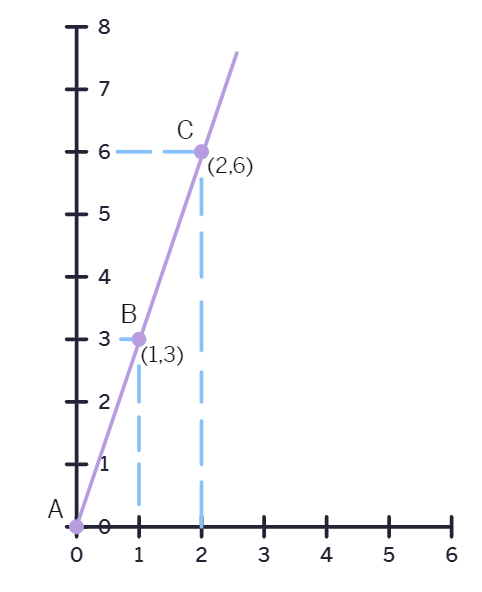
To verify from the graph, draw a perpendicular to the x-axis at the point (2, 0) meeting the graph at the point C. Clearly the coordinates of C are (2, 6). It means that the work done is 6 units.
Case Based Questions
Q1
Japneet went to the market to buy his favourite sweets. He had ₹ 380/- in his pocket and he was allowed to spend all the money if he wished. He decided to buy Burfis whose price was ₹ 400/- per kg and Besan Ladoos whose price was ₹ 300/- per kg. Let x represent the quantity of Burfis that Japneet could buy, in kgs, and y represent the quantity of Besan Ladoos that Japneet could buy, in kgs.
- If Japneet spent all the money he had, then which of the following is the correct representation of the amount of money spent by Japneet?
(a) 400x + 300y + 380 = 0 (b) 400x + 300y - 380 = 0
(c) 400x - 300y + 380 = 0 (d) 400x - 300y - 380 = 0
- Assuming that you have chosen the correct answer for the above question, if you plot that in the graph, then what does the x-intercept and the y-intercept represent?
Statement
x-intercept represents the quantity of ‘Burfi’ Japneet will get for ₹ 40 (Yes/No)
y-intercept represents the quantity of ‘Burfi’ Japneet will get for ₹ 300
x-intercept represents the quantity of ‘Burfi’ Japneet will get for ₹ 380
y-intercept represents the quantity of ‘Besan Ladoo’ Japneet will get for ₹ 380
- Japneet visited the same shop with the same amount of money after 2 weeks. But this time the price of Burfis had increased by 50 rupees per kg. If you rewrite the equation for the quantity of sweets that Japneet could buy for the money he had, then which of the following is correct?
(a) Coefficients of both x and y will be different
(b) Coefficient of x will be different but coefficient of y will be same
(c) Coefficient of y will be different but coefficient of x will be same
(d) There will be no change in the coefficients of x and y
Q2
Once a tortoise and a rabbit ran a race which was won by the rabbit because the rabbit was much faster than the tortoise. They decided to race again. The destination was 500 m away from the starting point. As the rabbit had won in the previous race by a large margin this time the tortoise was given a concession of 200 m. This means though both of them start at the same time, the rabbit will have to cover 500 m and the tortoise has to cover only 300 m. When the race began, the tortoise had moved with a constant speed of 15 metres per minute, till she reached the destination. The rabbit had covered the initial 300 metres in 0.5 minutes and then fell asleep for 30 minutes. After waking up, the rabbit again continued with the same speed that he had before falling asleep.
- Consider a graph with distance covered from the common starting point in metres along the y-axis and time taken in minutes along the x-axis. Then which of the following equations will accurately represent the distance of the tortoise from the common starting point on the graph?
(a) x =
(b) x = 15y + 200
(c) x =
(d) y = 15x - 200
- Which of the following graphs (I to IV) accurately represents the distance travelled by the tortoise with respect to time?
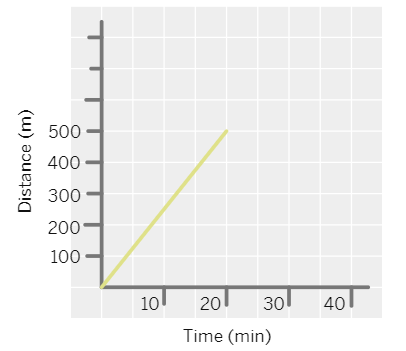
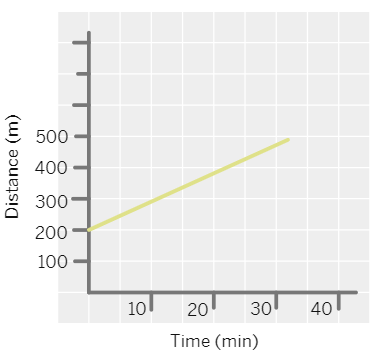
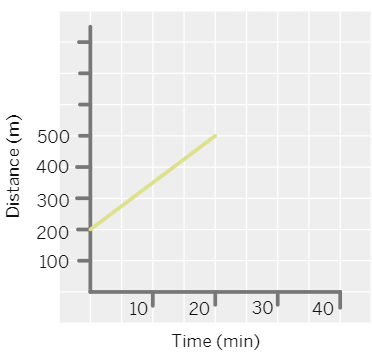

- The graph in Fig. 3.6 represents the distance covered by the rabbit with respect to time. As the rabbit had slept for some time during the race, that portion of the graph is denoted by “sleeping”.
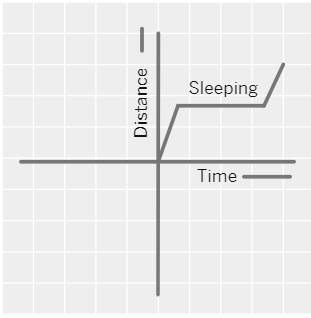
Which of the following equations represent the “sleeping” part of the graph:
(a) x = 0.5 (b) x = 20
(c) y = 200 (d) y = 300
- Who is the winner of the race?
(a) Rabbit
(b) Tortoise
(c) Both reach at the same time
(d) Can’t conclude with the given information
Q3
The following table represents the electricity tariff of Bengaluru:
| S No. | Number of Units | Price |
|---|---|---|
| 1. | 0 - 30 | ₹ 130/- (minimum) |
| 2. | 31 - 50 | ₹ 4.5 per unit |
| 3. | 51 - 100 | ₹ 7 per unit |
| 4. | 101 and above | ₹ 10 per unit |
- If we plot the price along the y-axis and number of units along the x-axis, which of the following graphs (I - IV) represents the variation of price with number of units?


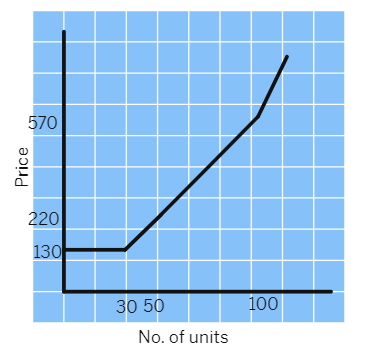

- In the Price vs Number of Units graph (right answer for Question 8), which of the following equations represents the part of the graph corresponding to the initial 30 units?
(a) x = 30 (b) y = 130
(c) x = 130 (d) y = 210
- Write down an expression, which represents the relationship between the y co-ordinate and the x co-ordinate of the graph, beyond 100 units.
